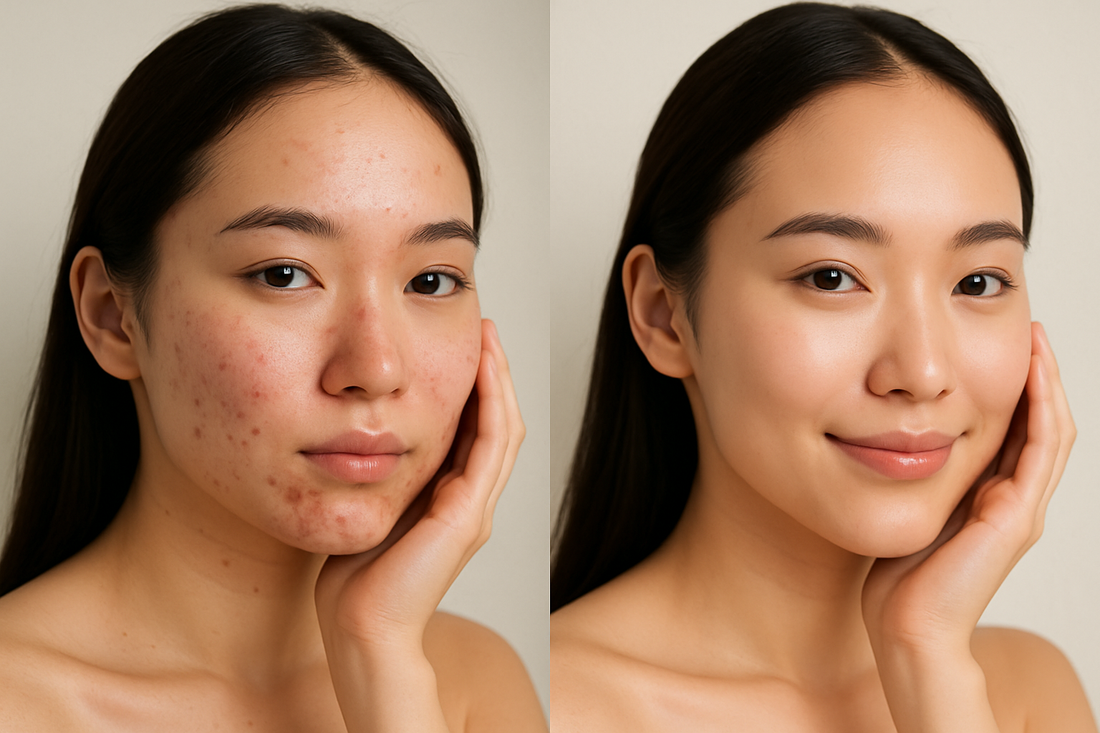
Fading Acne Marks & Hyper-pigmentation
Fading Acne Marks & Hyper-pigmentation: How Glutathione Helps - Backed by Clinical Research
Published by Glutagem Wellness | Science‑Led Skin Clarity
Acne marks and hyperpigmentation are common skin concerns, especially post-inflammatory discolouration that lingers long after active breakouts. Fortunately, glutathione—often called the “master antioxidant”—offers promising results in fading these marks and improving skin tone. Here’s how, according to clinical studies.
Why Glutathione Matters for Pigmentation
1. Correlation with Severity of Melasma
A cross-sectional study of 47 patients with melasma revealed a strong negative correlation between plasma glutathione levels and the Melasma Area Severity Index (MASI). In simple terms: the lower the glutathione, the more severe the pigmentation. This suggests glutathione plays a protective role against hyperpigmentation.
2. Oral Supplementation Reduces Dark Spots
A 12‑week randomised, double‑blind, placebo‑controlled trial (involving 124 Asian women) tested a combination of 500 mg L‑Cystine + 250 mg L‑Glutathione versus glutathione alone, cystine alone, or placebo. The results?
- Significant improvement in skin lightness.
- Noticeable reduction in dark-spot size at 6 and 12 weeks—significantly better than placebo or any single ingredient.
3. Topical Glutathione Shows Brightening Effect
In another study involving Indonesian women, facial products containing 0.1% or 0.5% reduced glutathione (GSH) significantly increased skin lightness (measured by ΔL* value) as early as week 2. By week 8, there was clear improvement in hyperpigmented lesions—particularly in the higher concentration group. Mild tingling was the only reported side effect.
4. Combining Oral & Topical Enhances Skin Brightness
A double-blind, randomised trial with 46 participants compared:
- Oral glutathione,
- Topical glutathione,
- Combination of both,
- Placebo.
The group receiving both oral and topical glutathione experienced the most significant reduction in melanin index and the greatest increase in brightness compared to either monotherapy or placebo.
5. The Bigger Picture: Evidence and Limitations
Reviews and expert commentaries highlight glutathione’s antioxidant and antimelanogenic mechanisms, including:
- Tyrosinase inhibition (the enzyme that drives melanin production),
- Shifting melanin from eumelanin to pheomelanin (lighter pigment),
- Reducing oxidative stress which worsens pigmentation.
However, clinical results are uneven across studies—likely due to differences in:
- Formulation (oral vs. topical),
- Dosing and treatment duration,
- Participant skin types,
- Endpoints and measurement methods.
Yet, many dermatologists still support the potential of glutathione—particularly as part of a comprehensive skincare strategy.
Summary Table: Glutathione’s Effects on Acne Marks & Pigmentation
| Mode of Use | Key Benefit |
|---|---|
| Oral (with cystine) | Reduced dark spots and improved skin lightness (12 weeks) |
| Topical (0.1–0.5% GSH) | Brightening and fade of hyperpigmentation (from week 2) |
| Combined Oral + Topical | Best results in melanin reduction and skin brightness |
| Plasma Levels | Lower glutathione correlates with worse pigmentation |
| Mechanisms | Tyrosinase inhibition, antioxidant action, melanin shift |
Clinical Takeaways for Dermatological Practice
- Dosage & Duration matter: oral glutathione is most effective when combined with L‑Cystine (250 mg) over at least 12 weeks.
- Topical glutathione works as a targeted treatment for hyperpigmented areas—especially in 0.5% strength within a supportive cream base.
- Synergistic formulation (oral + topical) yields enhanced results, leveraging both systemic and local action.
- Precision targeting of pigmentation—perfect for post-acne marks, melasma, or sun-induced spots.
-
Safety profile generally favourable; mild irritation is rare in topical use.
References:
- Wiraguna, A.A.G.P., Hari, E.D. and Praharsini, I.G.A.A. (2020). Correlation Between Glutathione Plasma with Degree Severity of Melasma in Balinese Women. Clinical, Cosmetic and Investigational Dermatology, Volume 13, pp.455–459. doi:https://doi.org/10.2147/ccid.s258834.
- Duperray, J., Sergheraert, R., Chalothorn, K., Tachalerdmanee, P. and Perin, F. (2021). The effects of the oral supplementation of L‐Cystine associated with reduced L‐Glutathione‐GSH on human skin pigmentation: a randomized, double‐blinded, benchmark‐ and placebo‐controlled clinical trial. Journal of Cosmetic Dermatology. doi:https://doi.org/10.1111/jocd.14137.
- Etnawati, K., Adiwinarni, D.R., Susetiati, D.A., Sauchi, Y. and Ito, H. (2019). The efficacy of skin care products containing glutathione in delivering skin lightening in Indonesian women. Dermatology Reports. doi:https://doi.org/10.4081/dr.2019.8013.
- https://www.facebook.com/JCADermatology (2025). Systematic Review of the Efficacy and Safety of Topical Glutathione in Dermatology | JCAD - The Journal of Clinical and Aesthetic Dermatology. [online] JCAD - The Journal of Clinical and Aesthetic Dermatology. Available at: https://jcadonline.com/efficacy-safety-topical-glutathione/?utm_source=chatgpt.com [Accessed 5 Sep. 2025].
- Naseem, A., Patil, A., Shukla, R., Agrawal, B. and Langade, D. (2024). Analysis of usage pattern of glutathione by dermatologists: Results of a cross-sectional study. IP Indian Journal of Clinical and Experimental Dermatology, 10(3), pp.323–327. doi:https://doi.org/10.18231/j.ijced.2024.057.
- Alzahrani, T.F., Alotaibi, S.M., Alzahrani, A.A., Alzahrani, A.F., Alturki, L.E., Alshammari, M.M., Alharbi, R.A., Alanazi, S.I., Alshammari, W.Z. and Algarni, A.S. (2025). Exploring the Safety and Efficacy of Glutathione Supplementation for Skin Lightening: A Narrative Review. Cureus, [online] 17(1). doi:https://doi.org/10.7759/cureus.78045.


